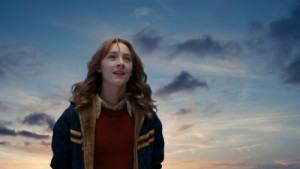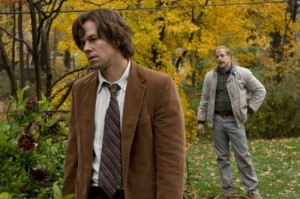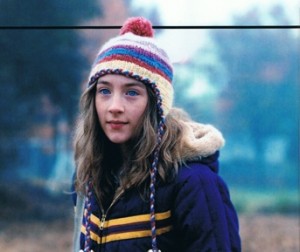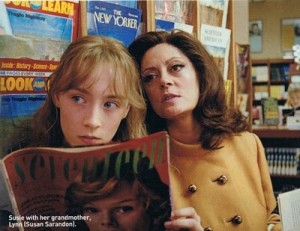 Seriously, how can director Peter Jackson ever top The Lord of the Rings trilogy? I don’t think it’s possible, but he definitely finds projects that challenge him, yet also speak to those fantastical sensibilities he so very fond of tapping into. King Kong and now his latest effort is to adapt Alice Sebold’s novel The Lovely Bones, a cerebral yet mystical tale of a murdered girl’s running dialogue in heaven, trying to heal her family and expose her killer. In an hour-long press conference, Jackson – along with his cast, including Saoirse Ronan (Susie Salmon), Rachel Weisz (Abigail Salmon), Susan Sarandon (Grandma Lynn), Stanley Tucci (Mr. Harvey), Mark Wahlberg (Jack Salmon) and Rose McIver (Lindsay Salmon) – talks about the process of bringing this transcendent novel to the screen.
Seriously, how can director Peter Jackson ever top The Lord of the Rings trilogy? I don’t think it’s possible, but he definitely finds projects that challenge him, yet also speak to those fantastical sensibilities he so very fond of tapping into. King Kong and now his latest effort is to adapt Alice Sebold’s novel The Lovely Bones, a cerebral yet mystical tale of a murdered girl’s running dialogue in heaven, trying to heal her family and expose her killer. In an hour-long press conference, Jackson – along with his cast, including Saoirse Ronan (Susie Salmon), Rachel Weisz (Abigail Salmon), Susan Sarandon (Grandma Lynn), Stanley Tucci (Mr. Harvey), Mark Wahlberg (Jack Salmon) and Rose McIver (Lindsay Salmon) – talks about the process of bringing this transcendent novel to the screen.
Step 1: How to adapt a book. Hey, it’s is hard to do!
Peter Jackson: “In my mind, there’s no such thing as a perfect adaptation of a book. The master work is the book. Alice Sebold’s novel is The Lovely Bones – that is the work that has everything in it, every character, every subplot and that’s the way you should experience the story in its most pure form. A film adaptation of ANY book, especially The Lovely Bones, is only ever going to be a souvenir, an impression of aspects of the book. So to me to adapt a book isn’t to produce a carbon copy, would be impossible. To include everything, the film would be five to six hours long. It’s a personal impression that Phillips Boyens, Fran Walsh and myself, the three of us wrote the screenplay and we responded to aspects of the book, especially emotional themes and the comforting value of the book and the things it had to say about the afterlife, which is personal to anybody. It’s what we responded to and our adaptation is just elements of the book restructured following our instincts and tastes. No adaptation is perfect, it’s impossible. You don’t make a movie for the fans of the book, you can’t do that.”
Step 2: How to personify evil – and leave it behind when you are done
Stanley Tucci: “It was hard in every respect. Pete knew I was very reticent to take the part. I can’t read or watch anything about kids getting harmed or anything about serial killers. And there’s so much serial killer information out there, documentaries and whatnot. A lot of it is just gratuitous, almost pornographic really, what’s being shown. But this was not that. This was a beautiful story about an exploration of loss. Phillpa, Fran, Pete and I had long conversations about it, and I felt safe with them that this wouldn’t be gratuitous and that we were going to create a person together. That Mr. Harvey was a real person. The more real he is, the more subtle and banal he is, the more terrifying he is. At the beginning, it was very hard to leave it at the end of the day, to drop it especially after being fresh off the research. It was repulsive. But once you understand who he is and you find him for me, then I could drop him at the end of the day. And no doubt, it was the most difficult thing I have ever done as an actor. I looked forward to going into the make-up trailer and taking everything off and having a martini at the end of the day. And at the beginning of every day, too, for that matter. ” [Laughter]
 Step 3: How to tap into a parent’s worst nightmare – and leave it behind when you are done
Step 3: How to tap into a parent’s worst nightmare – and leave it behind when you are done
Rachel Weisz: “As an actor, you have to imagine all sorts of things. I imagined I was a young woman in the 1970s, I imagined I was American – neither of those bad things. You imagine beautiful things, you imagine ugly things, that’s my job. I just don’t think that way, that something’s too dark or problematic to go to. I don’t know why but I just don’t think that way. I immerse myself in something but I’ve learned to come out of it. I’m a mother in real life, so I can’t go home to my kid in a state of despair and tears. It’s a skill you learn, like one might learn to juggle, that you learn to turn things on and off. But bad things happen in story since the beginning of time. So it isn’t a new thing to be a storyteller and be in a film where there are bad things. There are also beautiful and uplifting things about this film and the book, and I knew that going into it. You know what? I guess the uplifting theme of book to me is that life is a treasure, and precious and a miracle, which did make me want to hug my son tighter. It’s hard to remember life is a miracle. Often we’re just living it and forget that. It gave me a positive feeling rather then a depressed one.”
Mark Wahlberg: “Because of the way I approach work, I wasn’t that thrilled with the subject matter because I have one beautiful little girl and two beautiful boys. I don’t have the God-given talent like Rachel has and just snap into it. Have these floods of emotion coming out and then just turn them off. I’m still learning to juggle … I would just go home and grab my daughter and hold her and I would start crying. She’s like, ‘Daddy what’s wrong with you?’ She just wanted to play. And I would try to talk to her about taking care of herself and to not talk to strangers. She was 3 at the time. But thankfully, I had another movie to go into right after, so I was able to shake it after awhile.”
Step 4: How not to show a rape
Jackson: “There are artistic, moral, impractical reasons, a variety of them, really [for not showing the rape and murder]. The film is about a teenager and her experiences of what happens: she’s murdered, she goes into an after-life and we wanted to make a film that teenagers could watch. Fran and I have a daughter around Susie’s age, and we wanted Katie to be able to see this film. So it was important to us not to go into an R-rated territory at all. Also, I never regarded the movie as being a film about a  murder. And if we shot any aspect of that particular sequence … to show a 14-year-old girl murdered in any way, no matter how briefly, it would completely swing the balance of the movie. And frankly, make it a film that I wouldn’t want to watch. I would have no interest in seeing that depicted on film. Every movie that I make is a film that I want to see. It’s very important. I make movies that I know I’d enjoy seeing at the cinema … I’ve shot some pretty extreme things in my time, with Bad Taste and Meet the Feebles and Braindead, and there’s a certain style and sense of humor that I believe you can do to get away with that. But to do anything that depicted violence, especially towards a young person in a way that was serious, to me I’d have no interest in filming it. It would be repulsive.”
murder. And if we shot any aspect of that particular sequence … to show a 14-year-old girl murdered in any way, no matter how briefly, it would completely swing the balance of the movie. And frankly, make it a film that I wouldn’t want to watch. I would have no interest in seeing that depicted on film. Every movie that I make is a film that I want to see. It’s very important. I make movies that I know I’d enjoy seeing at the cinema … I’ve shot some pretty extreme things in my time, with Bad Taste and Meet the Feebles and Braindead, and there’s a certain style and sense of humor that I believe you can do to get away with that. But to do anything that depicted violence, especially towards a young person in a way that was serious, to me I’d have no interest in filming it. It would be repulsive.”
Tucci: “To that, we talked a lot about that and how far it should go when we were getting to know each other. And in our conversations, I ask, ‘We don’t really need to see this, do we?’ and we all agreed that no, not at all, we don’t need to see it. But then I had a conversation with a journalist this morning who said people were upset that the rape WASN’T shown and the killing. And I just don’t get that.”
Jackson: “I mean how much murder and killing do you need to see to be satisfied? How much to make someone happy?”
Tucci: “I don’t know. Obviously, a lot because there’s a lot out there. I think anyone who’s disappointed in that regard should go onto the Internet, they’ll find a lot of stuff like that. It’s so much more interesting what Peter did to me. To leave it to the audiences’ imagination, because our imagination of rape and murder are much greater than what anyone could ever put on film.”
Susan Sarandon: “Also [Susie’s] the narrator and she disassociates herself at that point. So to watch it happen, you’ll lose that element of her confusion and her displacement.”
Jackson: “One things we did that’s different from the novel in restructuring the screenplay is we had [Susie] fleeing from the murder … At the point her spirit becomes disconnected from her body, she’s running, across the field, into the streets, running home. Susie doesn’t know what has happened to her. She’s literally confused and finds herself in the in-between, essentially the world of dreams and the subconscious and she has to start to put the pieces of the puzzle together like a mystery. So showing the murder would have changed all that.”
 Step 5: How to add some comic relief, like the boozy, chain-smoking Grandma Lynn
Step 5: How to add some comic relief, like the boozy, chain-smoking Grandma Lynn
Sarandon: “The fun part was figuring out how to clean the house with a cigarette and a drink. That was a new area for me. Obviously, she’s been self-medicating for years in anticipation of some grief. Maybe she mourns in another movie but not this one. That’s not my job [as the character]. My job was to keep things moving forward. It’s really a great choice to have someone inept try to keep the house going. Cause if I was a seemingly solid, knitting granny you’d expect to come forward, it would be really boring. But the fact she’s throwing ashes everywhere she’s cleaning, it allows the audience to laugh in the appropriate places. I love that this is just the way life is. When something horrible happens, you do find yourself laughing in weird places in the midst of grief and crying in the supermarket when you see a cereal that somebody used to eat. There’s just no way of guarding yourself one way or another. Everyone griefs differently, there’s no right or wrong way. And my function in the film was to be hilarious. I’ve been there and have lost many a child on celluloid, so I was happy I was once removed.”
Step 6: How to play in the “in-between”
Saoirse Ronan: “There were quite a lot of scenes on my own in the in-between. We actually did go on location in New Zealand, which was beautiful, a great experience. But when we used blue screen, there were different things that they figured out would help me. Of course, how well written the script was. Really, most of what I needed was in the script already. We would also play music during the day, during the shots. Music that would reflect the mood of the scene, which would help so much. Pete would talk to during takes as well, describing what was around me. I never really felt like I was alone, because I had my guardian angel there [looks at Peter Jackson] … and I loved New Zealand, very similar to Ireland. One of my favorite places to shoot and visit. I’d move there.”
“For me, there was always one scene that stuck out I got very emotional with, where I was drowned in the scene for quite a long time: It was the barley field scene towards the end in which Mr. Harvey’s victims come to take Susie to heaven. One of my favorite scenes in the film and definitely my favorite to shoot. It was so emotional and touching.”
Step 7: How to believe in the afterlife
Jackson: “I think everyone has their own points of view about it. We didn’t want to make a film that cast judgment on people’s religious beliefs because that wasn’t at all the motivation for making the movie … all religion aside, I do think that there is some energy we do have inside us. I have experienced a couple of people that have been close to me dying, and I held their hand and there is a feeling that when someone passes on, that they leave. There’s a sense of departure that’s very, very strong. And it’s been so strong that it leads me to believe there’s a form of energy inside us that continues to survive. Physics tells us that the energy cannot be destroyed, it has to go somewhere. It doesn’t evaporate.”

